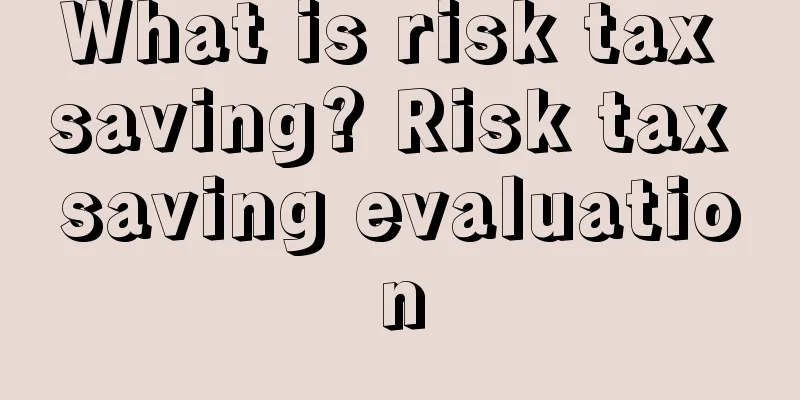What is risk tax saving? Risk tax saving evaluation

|
Risk Tax Saving Type Glossary Risk tax saving refers to reducing risk to the minimum in a certain period and under certain circumstances to obtain tax savings that exceed general tax savings. Risk tax saving mainly considers the risk value of tax saving. Classification Risk tax saving can be divided into two types: deterministic risk tax saving and uncertain risk tax saving. 1. Certainty of risk tax saving Some tax saving risks have certainty, such as tax incentives in different countries, tax rate differences in different countries, etc. In addition, changes in tax systems in different countries, economic cycles, market interest rates, inflation, the development of the enterprise itself and the range of changes in earnings have certainty. These deterministic risk factors must be taken into account when saving taxes, and can be taken into account as a quantitative factor. This kind of risk saving is called deterministic risk saving. In deterministic risk tax saving, we generally use probability theory to quantify risks based on past data and experience, and use the expected value calculation method to select tax saving plans. 2. Uncertainty risk tax savings Risks are somewhat uncertain. The deterministic risks mentioned above are only relative. In real life, many tax savings involve uncertain risks. For example, the exchange rate issue in international tax savings is highly uncertain. It is difficult for anyone to correctly predict the change in exchange rates. The tax savings from cross-border transactions may be completely offset or even increased due to the change in exchange rates. Therefore, the uncertainty risk factor must also be considered when saving taxes. We call this risk tax saving uncertainty risk tax saving. For the uncertainty factors of tax saving, the usual practice is to use subjective probability to calculate the risk level and risk value. First, the uncertainty factors are converted into certainty factors through subjective probability, and then quantitative analysis can be carried out. Subjective probability refers to the value of the probability of random events reasonably estimated by people based on limited information and experience in the absence of a large amount of historical data and actual experience. Since the degree of deviation between uncertain tax saving schemes and actual results is often greater than that of deterministic tax saving, in order to ensure the feasibility of tax saving, the degree of deviation of tax saving results from expected values, that is, the degree of risk, must be considered. We generally use standard deviation to reflect the degree of risk of uncertain tax saving: the larger the standard deviation, the greater the degree of risk. However, standard deviation is an absolute value and can only be used for tax saving schemes with the same expected tax value. For uncertain tax saving schemes with different expected tax values, the standard deviation rate should be used to reflect the degree of risk. Similarly, the larger the standard deviation rate of the tax saving scheme, the greater the degree of risk. |
<<: What is a Wish Trustworthy Store? Wish Trustworthy Store Review
>>: What is Zhiquancheng? Zhiquancheng Review
Recommend
I have a hard time. My new product advertisement has over 10,000 daily exposures but only 0.02% clicks! How can I increase the click-through rate of my advertisement?
Anonymous user My C position New product on the sh...
The most amazing thing in history! A fake order actually caused the US government to investigate!
According to foreign media reports, a message has ...
Etsy launches new top seller program! Sellers are dissatisfied with the measurement indicators
It is learned that according to foreign media repo...
Amazon store marketing and daily management multi-dimensional automated statistics and weekly ROI automated tracking form
Weekly ROI tracking spreadsheet ...
What is HiShop? HiShop Review
HiShop is a domestic e-commerce software and relat...
What is MEIG? MEIG Review
MEIG (The Middle East Internet Group) was establis...
What is TaxJar? TaxJar Review
TaxJar makes sales tax filing easier for more than...
The post office stopped picking up parcels?! Amazon suspends promotional services
Urgent! eBay officially released a message saying ...
The United States will impose an additional 10% tariff on Chinese goods, effective March 4
On February 27, 2025, local time, US President Tru...
A manual to close the five illegal operations of Amazon off-site traffic diversion
Amazon’s announcement pointed out that specificall...
Are reviews risky? Amazon's fake review rules have come into effect, and bad reviews that violate the rules will be banned
text On the Amazon platform, the problem of "...
Autumn product selection guide: These products will become hot sellers
As autumn approaches, sellers are looking for hot-...
What is the solidarity surcharge? Solidarity surcharge review
Solidarity surcharge (Solidaritätszuschlag also kn...
What is the Amazon Vine Program? Amazon Vine Program Review
Amazon Vine is a program that Amazon invites the m...
What is Seller Locker? Seller Locker Review
Seller Locker is a company that manages FBA pickin...









